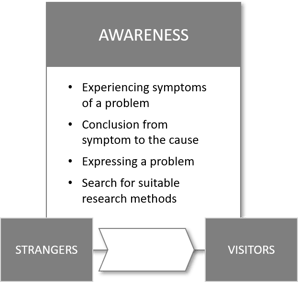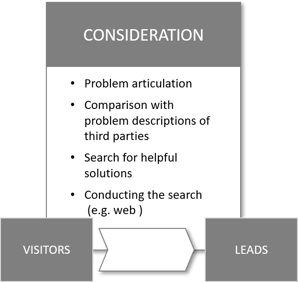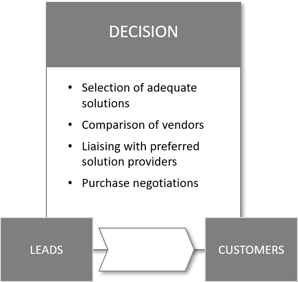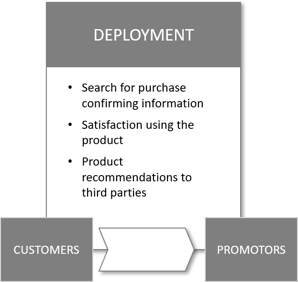Meeting the customer's need for information
Would you like to increase your conversion rates? Reach more potential customers and move them more effectively and efficiently through the Sales Funnel?
Use a customer journey/user journey to understand when a potential customer comes into contact with your product or company, where and with what consequences. Decipher the essential contact points (touchpoints) and optimize them so that positive customer experience (customer experience management) is created and the probability of purchase, for example, increases.
The Customer Journey or user journey represents the path of a potential customer/buyer persona from the first encounter with your product or brand to the conclusion of the sale. Collecting information, discussing with acquaintances, contacting your service - each touchpoint is illustrated on a Customer Journey Map. Depending on the size of the company or the complexity of the product, the number of touchpoints can vary.
Touchpoints can be stored online or offline. To create awareness, you can, for example, place advertising on Facebook or Google and place posters at relevant locations. If a potential customer moves to a later phase on your website or through a forum according to experience reports, he is mainly online. However, a conversation with a sales consultant in a branch office is offline again. The challenge is to understand what a potential customer is doing across many channels. The next step is to help them identify your offer as the most suitable one and decide in favor of it.

Customer Journey Mapping describes the process of developing a Customer Journey. The goal of this map is to present the tasks of each touchpoint clearly and comprehensibly. Possible tasks are:
Meeting the customer's need for information
In order to sustainably ensure the quality of the interaction, recommendations for action can be recorded for those responsible at the touchpoint.
The following is an example of a Customer Journey Map for the purchase of a car. In general, it can be assumed that the decision and deployment phase for products in this price category is much longer than for clothing, for example. A variety of touchpoints (yellow = offline; green = online) are also passed through, some of which are outside the company's own sphere of influence. Nevertheless, they must be mentioned and included as much as possible in order to optimize the customer experience.
The Customer Journey Map provides a good basis for effective customer experience management. Once the touchpoints have been identified, each one can be assigned importance for the overall process. In combination with a customer's satisfaction with this interface, there are possible pain points and starting points for improvement.


In the Awareness Phase of the Customer Journey, the person notices a problem and tries to identify it more precisely. The broken car clearly requires an expert assessment, which is why an appointment was made in the workshop.
The previous attitude towards the brand of an automobile manufacturer (or the middleman) is formed from a variety of influences. Public opinion, positioning in online and offline media, and the assessment of friends play a role here, for example.
The manufacturer chosen here stands out positively through all advertising measures but is critically questioned by the public. From the evaluation of the individual touchpoints, there is room for improvement in the organic search and the playout of email campaigns.

In the Consideration Phase of the Customer Journey, the person already knows what exactly their problem is. In this case, the car may be unfit to drive due to an engine failure. The two solutions in our example are easy to see: buy a replacement engine and have it installed, or choose a new car. Because of the high repair costs and old age, the person is looking for a new car.
The search for information begins on the Internet. Product tests, testimonials from previous users, awards from independent bodies. These and other influencing factors determine the online search process. Offline, the person listens to their friends and also gets advice from the garage and the dealer.
In this example, the car manufacturer gives out little information about itself. Neither in blogs nor in newsfeeds is much published. Only tests conducted by independent bodies report in detail on the quality and condition of the product. The opinion from the circle of friends strengthens the potential buyer, but the dealer seems to respond little to wishes and, for example, always suggests too expensive vehicles.

In the Decision Phase of the Customer Journey, the potential buyer already has a solution in mind and is looking for the exact vehicle in this case.
Comparisons in trade journals or online forums, awards by trustworthy third parties, and information material of any kind are carefully examined in this phase. Competitive products are used to identify performance standards and qualitative differences. The narrowest selection will be tested and only one car will enter the actual buying process.
In our example, it becomes clear that the representation of the product in the online area is perceived positively. Trade journals report, information material is comprehensibly structured and easily accessible. Only online forums report less vividly about experiences. In offline contact with the retailer, there is little flexibility. The limited choice of vehicles and the long delivery time also contribute to less pleasant customer experience.

The purchase has already been completed during the Deployment Phase of the Customer Journey. Now the main task is to bind the customer to the brand through outstanding service and to inspire them in the long term (Customer Relationship Management). The positive presentation and friendly service ensures trust and leads to a good reputation.
Contact in the online environment takes place via direct contact in emails or via social media channels and a lively community. In the event of problems with the product, however, the customer seeks offline contact with the dealer and the workshop.
While the presentation in social media is positive, the emails are not very appealing and the interaction in the community is uninteresting. The entire offline contact is unsatisfactory and therefore requires special focus in the process of customer experience management.
The way to more insights does not lead past the Customer Journey. In the following steps we will help you to a Customer Journey / User Journey and show you where is room for improvement:
During each phase, contact is established with a large number of departments to ensure that the Customer Journey Mapping process is holistic and realistic. This also increases the quality of the data and acceptance in the analysis of problems.
About TLS
Contact
Newsletter